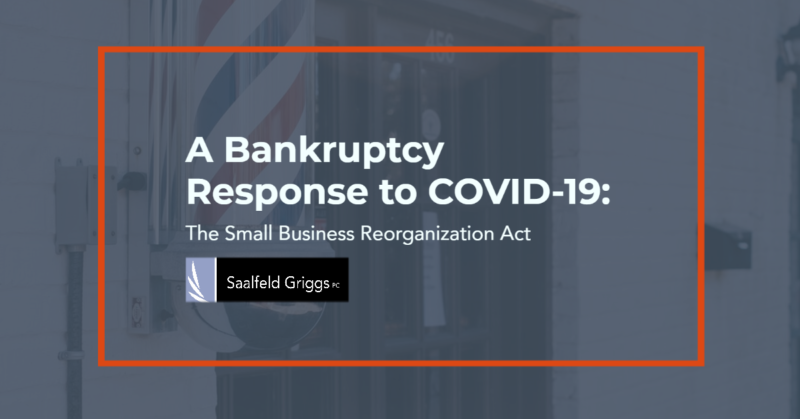By Erich Paetsch, Attorney in the Creditors’ Rights & Bankruptcy and Litigation Practice Groups
In response to the COVID-19 pandemic that is drastically impacting the United States we know, many lenders significantly increased loan loss reserves.[1] Recognizing that the economic impact of public health measures has rapidly pushed the United States into a projected recession, lenders are preparing for collateral damage to loan portfolios.
Coincidentally, on February 19, 2020, the Small Business Reorganization Act of 2019 (“SBRA”) took effect.[2] SBRA was a congressional response to concerns that most small business debtors filing bankruptcy face difficulty successfully reorganizing under Chapter 11 of the Bankruptcy Code. As a result, SBRA provides a new mechanism for small businesses to reorganize under the Bankruptcy Code: subchapter V of chapter 11. Because struggling small businesses impacted by COVID-19 may pursue relief under the SBRA, it is important for lenders to be familiar with this new option and how it impacts prior experience and traditional assumptions.
Eligibility
To file for bankruptcy relief under SBRA, a small business must meet the definition and debt limits imposed by Congress. Any debtor engaged in commercial or business activities is eligible except those whose primary activity is the owning of single-asset real estate. SBRA permits a debtor with no more than $2,725,625 in secured and unsecured debt to seek relief under its provisions. However, in recognition of the need for bankruptcy reorganization due to the economic impact of COVID-19, Congress temporarily increased the so-called debt cap to $7,500,000 as part of the Coronavirus, Aid, Relief and Economic Security Act (“CARES”) through March 27, 2021. As a result, many more small businesses are now eligible for and may elect for SBRA treatment under the Bankruptcy Code.
Governance and Oversight
SBRA retains many of the governance and oversight features lenders are already familiar with as part of a business bankruptcy. Like other business bankruptcies, the small business debtor remains a debtor-in-possession (“DIP”) under SBRA. This means the DIP continues to run the business during the bankruptcy and controls the property of the business. However, a unique feature of SBRA is that only the DIP has the power to file a plan of reorganization under SBRA. This effectively tilts the governance power in favor of the debtor and away from creditors. Without such powers, SBRA limits the impact lenders can have in objecting to the DIP’s preferred form and process for reorganization.
Perhaps the single biggest change under SBRA is that a trustee will be appointed regardless of DIP status. This is a substantial change from many prior small business cases that lacked oversight or meaningful creditor engagement. The duties of a trustee under SBRA are familiar. They are like those of a trustee under Chapter 12 of the bankruptcy code, including conducting a meeting of creditors, collecting and distributing payments, etc. However, SBRA includes some important additional duties including that the trustee must appear at all status conferences and must “facilitate the development of a consensual plan of reorganization”. Presumably, this provision is intended to improve the chances of a successful reorganization plan. As a result of COVID-19, the SBRA requirement of an independent trustee facilitating a mutually beneficial plan may benefit everyone working to find common ground and a successful reorganization story for less sophisticated small businesses. However, we have little guidance on what trustee facilitation looks like and what standards the court might impose upon the trustee and parties to ensure facilitation occurs.
Time Frames
Unlike many business bankruptcies, SBRA imposes strict time limits for action upon the filing of an eligible bankruptcy petition. The court is required to hold a status conference within 60 days of the petition date to further the prompt resolution of the case and the DIP must file a report detailing its efforts to obtain an agreed-upon plan of reorganization by that time. The DIP also had a deadline to file its plan within 90 days of the petition date and cannot exceed five years in length. Each deadline is significantly quicker than prior requirements under the Bankruptcy Code.
Significant Changes Impacting Lenders
The SBRA includes two major changes, among others, that lender should note. Traditionally, proposed plans in Chapter 11 of the Bankruptcy Code must satisfy something called the absolute priority rule. Lenders are familiar with this standard because it requires a Chapter 11 plan to be “fair and equitable” to classes of impacted creditors. Litigation surrounding the absolute priority rule is commonly used by lenders to challenge treatment in proposed bankruptcy plans. SBRA completely eliminates voting or the absolute priority rule process removing these requirements to improve a lender’s position in a plan. Instead, lenders are left with a more general fair and equitable standard that is not further defined in SBRA. In addition, SBRA permits a DIP to modify or “cram down” a claim secured by the principal residence of the DIP in Chapter 11. This was not permitted before SBRA. As a result, individuals filing for bankruptcy under Chapter 11 who could not previously cram down a residential secured loan may now do so.
Conclusion
As lenders anticipate the economic repercussions of public health measures used to combat the spread of COVID-19, inevitably borrowers will turn to the Bankruptcy Code. The recent adoption of SBRA is a new tool that many small businesses may pursue relief from challenging economic conditions. Understanding SBRA and how it alters prior experiences and common assumptions about small business Chapter 11 bankruptcies is important to ensure a lender can react quickly to newly appointed SBRA trustee’s efforts to rapidly facilitate an acceptable plan of reorganization.
[1] See Laura Noonan, “US Banks Brace for Financial Losses” Financial Times, April 18, 2020.
Erich Paetsch is a partner in the Litigation and Creditors’ Rights & Bankruptcy practice groups and a member of the Financial Services and Construction Industry Groups. The information in this article is not intended to provide legal advice. For professional consultation, please contact Erich at Saalfeld Griggs PC. 503.399.1070. epaestch@sglaw.com © 2020 Saalfeld Griggs PC

